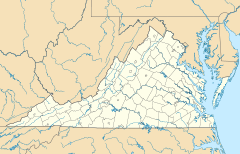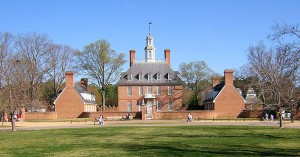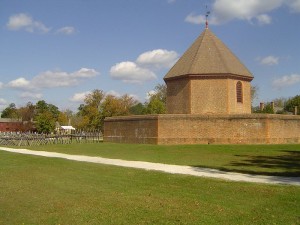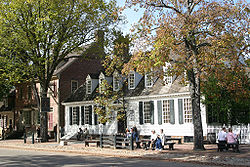Colonial Williamsburg
http://en.wikipedia.org/wiki/Colonial_Williamsburg
A Day at Colonial Williamsburg
Highlights from a day experiencing the sights and sounds at Colonial Williamsburg, Virginia. Finley-Holiday Film’s “Where America Began” Blu-ray/DVD features the story of Virginia’s historic triangle of Jamestown, Williamsburg and Yorktown. Together, these three towns form a historical continuity of Sir Raleigh’s dream of a new English colony in the New World: Jamestown – the beginning of the colonies; Williamsburg – the apex of the colonial era; and Yorktown, the end of the colonial dream and birth of a new American nation. Where America Began Blu-ray, DVD and Download Card are available on location at Colonial Williamsburg and at finleyholiday.com. For information on a visit to Colonial Williamsburg, visit www.history.org.

View of the reconstructed Raleigh Tavern on Duke of Gloucester Street
Colonial Williamsburg is a living-history museum and private foundation representing the historic district of the city of Williamsburg, Virginia, USA. The 301-acre (122 ha) Historic Area includes buildings dating from 1699 to 1780 which made colonial Virginia’s capital, as well as Colonial Revival and more recent reconstructions.
Early in the 20th century, the restoration and re-creation of Colonial Williamsburg, one of the largest such projects in the nation, was championed byW. A. R. Goodwin and the patriarch of the Rockefeller family, John D. Rockefeller, Jr., along with his wife, Abby Aldrich Rockefeller, to celebrate the patriots and the early history of the United States. Today it is a major tourist attraction for the Williamsburg area, and is part of the Historic Triangle of Virginia area, which includes Jamestown and Yorktown, linked by the Colonial Parkway. The site has been used for conferences by world leaders and heads of state, including U.S. Presidents. In 1983, the United States hosted the first World Economic Conference at Colonial Williamsburg. The Historic area is located immediately east of The College of William & Mary.
 The motto of Colonial Williamsburg is “The future may learn from the past.” The Historic Area is an interpretation of a Colonial American city, with exhibits including dozens of authentic or re-created colonial houses and relating toAmerican Revolutionary War history. Prominent buildings include the Raleigh Tavern, the Capitol, The Governor’s Palace (all reconstructed), and Bruton Parish Church (original). Rather than an effort to preserve antiquity, the combination of restoration and re-creation of the entire colonial town attempts to re-create the atmosphere and the ideals of 18th-century American people and revolutionary leaders. Interpreters work and dress as they did in the era, using colonial grammar and diction (although not colonial accents).
The motto of Colonial Williamsburg is “The future may learn from the past.” The Historic Area is an interpretation of a Colonial American city, with exhibits including dozens of authentic or re-created colonial houses and relating toAmerican Revolutionary War history. Prominent buildings include the Raleigh Tavern, the Capitol, The Governor’s Palace (all reconstructed), and Bruton Parish Church (original). Rather than an effort to preserve antiquity, the combination of restoration and re-creation of the entire colonial town attempts to re-create the atmosphere and the ideals of 18th-century American people and revolutionary leaders. Interpreters work and dress as they did in the era, using colonial grammar and diction (although not colonial accents).
Description
 The Governor’s Palace, reconstructed in the 1930’s.
The Governor’s Palace, reconstructed in the 1930’s.
Colonial Williamsburg is a combination of a historical landmark and a living historymuseum. Many of the missing Colonial structures were reconstructed on their original sites during the 1930’s. Others were restored to estimates of 18th-century appearance, with traces of later buildings and improvements removed. Dependency structures and animals add to the ambience. Most buildings are open for tourists, with the exception of buildings serving as residences for Colonial Williamsburg employees.
Notable structures include the Capitol and the Governor’s Palace, each re-created and landscaped as to what is known of their late 18th-century condition, as well as Bruton Parish Church and the Raleigh Tavern. The Wren Building on the campus of William and Mary was one of the first buildings to be restored.
Locals, students, and employees frequently call Colonial Williamsburg “CW”. The main portion is sometimes called the “Restored Area” or more often the “Historic Area.” One of the main streets, Duke of Gloucester, is called “DoG Street.”
History of Williamsburg, Virginia
 Colonial Williamsburg magazine
Colonial Williamsburg magazine
The statehouse (capitol building) in Jamestown, Virginia burned on October 20, 1698. The legislators found themselves meeting at Middle Plantation. In 1699, in a meeting held by the colonists, a group of students from The College of William & Mary submitted a proposal to move the capital to Middle Plantation, to escape malaria and mosquitoes that plagued the Jamestown Island site. The capital of the Virginia Colony was relocated to Middle Plantation. Middle Plantation was renamed Williamsburg by Royal Governor Francis Nicholson, proponent of the change, in honor of King William III. The new site was described by Nicholson as a place where “clear and crystal springs burst from the champagne soil” and was seen as a vision of future utopia. He had the city surveyed and a plan laid out by Theodorick Blandtaking into consideration the fine brick College Building and Bruton Parish Church. The main street was named Duke of Gloucester after the eldest son of Queen Anne.
At the time the main street was rechristened after the Duke of Gloucester, it was a simple horse path that veered through a set of swampy ravines and was obstructed at one point by houses and an oven. On April 27, 1704, Francis Nicholson asked the House of Burgesses to allow purchase of four old homes on the site so they could be demolished. On May 5, Henry Cary and his workers tore the homes down, and gave the owner of the property, Col. John Page, £5 and let him have the bricks from the razed homes. The transaction may be the first documented condemnation proceeding in American history.
For most of the 18th century, Williamsburg was the center of government, education and culture in the Colony of Virginia.George Washington, Thomas Jefferson, Patrick Henry, James Monroe, James Madison, George Wythe, Peyton Randolph, and others molded democracy in the Commonwealth of Virginia and the United States here. During the American Revolutionary War, in 1780, the capital of Virginia was moved to Richmond, about 55 miles (90 km) west for security reasons, where it remains today.
History of Colonial Williamsburg
With the seat of government removed, the colonial section of Williamsburg was neglected as the modern town was built around it. By the early 20th century, many older structures were in poor condition, and were no longer in use. The site on high ground and away from waterways was not reached by the early railroads, whose construction began in the 1830’s, and only was reached by the Chesapeake and Ohio Railway through the area in 1881.
Williamsburg relied on three institutions for jobs for its people: The College of William & Mary, the Courthouse and the Eastern Lunatic Asylum (now Eastern State Hospital),; it was said that the “500 Crazies” of the asylum supported the “500 Lazies” of the College and town. Colonial-era buildings were neglected in the wake of the Civil War, which had a much larger presence in the minds of the townsfolk. Williamsburg had Civil War commemorations every year, one on May 5, the anniversary of the Battle of Williamsburg. On May 5, 1908, Williamsburg dedicated a monument to Confederate soldiers and sailors and placed it prominently on the Palace Green.
PBS & Colonial Williamsburg Electronic Field Trip “When Freedom Came”
My Mother, Sylvia Tabb Lee, daughter and I had an opportunity to create a learning experience for students. Bring your children & students to Colonial Williamsburg without ever leaving the classroom! The Colonial Williamsburg Electronic Field Trips allow students to travel through time to experience life in colonial America. Everyone knows Abraham Lincoln freed all the slaves . . . or did he? Freedom came to enslaved people over the course of many months and years — and it arrived in different ways in different places. In the fifth installment in this seven-part series, entitled When Freedom Came, discover how enslaved Americans made everyday choices during the Civil War that helped bring about their freedom ….. Brandon Lee
Dr. Goodwin and the Rockefellers

Print of the Bodleian Plate, a ca. 1781-82 printing plate used to reconstruct the Capitol, Governor’s Palace, and to restore the Wren Building.
The Reverend Dr. W.A.R. Goodwin, became rector of Williamsburg’s Bruton Parish Church in 1903. The energetic 34-year old native of Nelson County was soon leading a successful campaign to restore the historic church building, which had been built beginning in 1711. Goodwin was an instructor at William & Mary. He completed the church restoration in time for the 300th anniversary of the founding of the Anglican (Episcopal) Church in Virginia in 1907.
Goodwin was transferred by the Church, and worked in upstate New York until his return in 1923 to work at William & Mary. What he saw in further deterioration of colonial-era buildings both saddened and inspired him. In 1924, fearing that the many other historic buildings in the area would be destroyed as time went on, he started a movement to preserve the buildings in the historic section of the town. After working for several years to interest potential individuals or organizations to assist with funding, Goodwin drew the interest (and major financial commitment) of John D. Rockefeller Jr., the wealthy son of the founder of Standard Oil. Rockefeller’s wife, Abby Aldrich Rockefeller was also to play an active role.
Re-creation and restoration started on November 27, 1926 with Arthur Shurcliff as the chief landscape architect and Perry, Shaw & Hepburn as architects. Concerned that prices might rise if their intentions were known, Rockefeller and Goodwin kept their plans a secret, quietly buying properties. Williamsburg attorney Vernon M Geddy, Sr. was taken into Goodwin’s confidence in his role as Rockefeller’s silent partner and did much of the title research and legal work related as properties in what was to become the restored area were acquired for the project. (Geddy later drafted the Virginia corporate papers for the project, filed them with the Virginia State Corporation Commission, and served briefly as the first President of the Colonial Williamsburg Foundation. That much property suddenly changing hands was noticeable, and after eighteen months of increasingly nervous rumors, Goodwin and Rockefeller finally revealed their plans at two town meetings on June 11 and 12, 1928.
Some townspeople had qualms. Major S. D. Freeman said, “We will reap dollars, but will we own our town? Will you not be in the position of a butterfly pinned to a card in a glass cabinet, or like a mummy unearthed in the tomb of Tutankhamun?”
During the restoration, the project demolished 720 Williamsburg buildings that postdated 1790, many of which dated from the 19th century. Since then, Colonial Williamsburg has been nearly completely re-created. It features shops, taverns and open-air markets in the colonial style. The Governor’s Palace and the Capitol building were among the significant colonial-era buildings that had not survived into the 20th century, and the structures were reconstructed at the original sites with the aid of period illustrations and written descriptions. Of the approximately 500 buildings in the historic area, 88 are original. The grounds and gardens were all reconstructed in the Colonial Revival style. In the western side of the district, beginning in the 1930’s, retail shops were grouped under the name.
One of the most prominent of the rebuilt structures is the Capitol, the 1930s re-creation of the 1705 building, designed by the architects Perry, Shaw & Hepburn. The new Capitol was dedicated with a ceremonial meeting of the Virginia General Assembly on February 24, 1934. As a tradition in Virginia, since 1934, Virginia’s state legislators have reassembled for a day every other year in the Capitol building at the east end of Colonial Williamsburg’s Historic Area.
Outlying lands and landscaping
Beginning in the earliest periods of the Restoration, Colonial Williamsburg acquired acreage in Williamburg and the two counties which adjoin it, notably to the north and east of the Historic District. One of the major considerations was a desire to preserve natural views and facilitate the effort to allow a visitor to experience as much of the late 18th-century experience as possible with regard to the surrounding environment. This was described as a “rural, wooded sense of arrival” along corridors to the foundation’s Historic Area. In announcing a conservation easement in 2006, CW Chairman Colin G. Campbell stated: “This view shed helps to set the stage for visitors in their journey from modern day life into the 18th-century setting. At the same time, this preserves the natural environment around Queen’s Creek and protects a significant archaeological site. It is a tangible and important example of how the Foundation is protecting the vital greenbelt surrounding Colonial Williamsburg’s Historic Area for future generations.”
The entrance roadways to the Historic Area were planned with great care. The Colonial Parkway was planned and is maintained to reduce modern intrusions. Near the principal planned roadway approach to Colonial Williamsburg, similar design priorities were employed for the relocated U.S. Route 60 near the intersection of Bypass Road and North Henry Street. Prior to the restoration, U.S. Route 60 ran right down Duke of Gloucester Street through town. To shift the traffic away from the Historic Area, Bypass Road was planned and built though farmland and woods about a mile north of town. Shortly thereafter, when Route 143 was built as the Merrimack Trail (originally designated State Route 168) in the 1930’s, the protected vista was extended along Route 132 in York County to the new road, and two new bridges were built across Queen’s Creek.
About 30 years later, when Interstate 64 was planned and built in the 1960s and early 1970s, from the designated “Colonial Williamsburg” exit, the additional land along Merrimack Trail to Route 132 was similarly protected from development. Today, visitors encounter no commercial properties before they reach the Visitor’s Center, although the land is very valuable and the distance is several miles.
Not only highway travel was considered. Although Williamsburg’s brick Chesapeake and Ohio Railway passenger station was less than 20 years old and one of the newer along the rail line, it was replaced with a larger new one in Colonial style which was located just out of sight and within walking distance of the Historic Area. Today, this circa-1935 building has been restored and modernized, and serves as the intermodal Williamsburg Transportation Center, with Amtrak, Greyhound Lines and other local and regional bus services, and other transport modes consolidated there.
The area to the immediate east of the Historic Area in James City County included a vast tract known as the Kingsmill Plantation property. It was bisected by the historic Quarterpath Road, dating to the 17th century, which led from Williamsburg to the James River at Burwell’s Landing. The manor house, built in the 1730’s, had burned in 1843, but several brick dependencies survived (and still do into the 21st century). Immediately to the east of the Kingsmill tract was Carter’s Grove Plantation. It was begun by a grandson of Royal Governor Robert “King” Carter. For over 200 years, it had gone through a succession of owners and modifications. In the 1960’s after the death of its last resident, Ms. Molly McRae, Carter’s Grove Plantation came under the control of the Rockefeller Foundation, which gave it to Colonial Williamsburg as a gift.
(Carter’s Grove, at a distance of 8 miles (13 km), was operated until 2003 as a satellite facility of Colonial Williamsburg, with several important programs. Most of the programs were relocated to be closer to the Historic Area, and the property was sold in 2007, with restrictive and conservation covenants to protect it. See separate article Carter’s Grove for more details).
Between Carter’s Grove and the Historic District was the largely vacant Kingsmill tract, as well as a small military outpost of Fort Eustis known as Camp Wallace. In mid-1960’s, CW owned land that extended all the way from the Historic District to Skiffe’s Creek, at the edge of Newport News near Lee Hall. Distant from the Historic Area and not along the carefully protected sight paths, the vacant tract was long unproductive for either CW or the community. That changed in the early 1970’s, under CW Chairman Winthrop Rockefeller.
Rockefeller, a son of Abby and John D. Rockeller Jr., was a frequent visitor and particularly fond of Carter’s Grove in the late 1960’s. He also served as Governor of the State of Arkansas. He became aware of some expansion plans elsewhere on the Peninsula of his St. Louis-based neighbor, August Anheuser Busch, Jr., head of Anheuser-Busch (AB). A businessman and promoter, he had originated the use of the now famous Clydesdale team as a company logo in the 1930’s. In 1959, the company had opened what today is known as a theme park in Tampa, Florida which was known as simply “Busch Gardens.” It was visionary, and predated the massive Walt Disney World development nearby by several years; today it is known as Busch Gardens Tampa Bay.
By the time “Win” Rockefeller and “Gussie” Busch completed their discussions, the biggest changes in the Williamsburg area were underway since the Restoration began 40 years earlier. Among the goals were to complement Colonial Williamsburg attractions and enhance the local economy.
The large tract consisting primarily of the Kingsmill land was sold by the Colonial Williamsburg Foundation to Anheuser-Busch(AB) for planned development. The AB investment included building a large brewery, the Busch Gardens Williamsburg theme park, the Kingsmill planned resort community, and McLaws Circle, an office park. AB and related entities from that development plan comprise the area’s largest employment base, surpassing both Colonial Williamsburg and the local military bases. In 2008, Anheuser-Busch ranked as the world’s second largest brewer.
Late 20th century
Colonial Williamsburg has become one of the most popular tourist destinations in Virginia. With its historic significance in democracy, it and the surrounding area have been the site of many summit meetings of world leaders, notably the first World Economic Conference in 1983. Colonial Williamsburg has also hosted visiting royalty from several nations, including King Hussein of Jordan and Emperor Hirohito of Japan. Queen Elizabeth II has paid two royal visits to Williamsburg, most recently in May 2007 during the 400th anniversary of the founding of the nearby Jamestown Settlement.
The popular American Girl character, Felicity Merriman, is from Colonial Williamsburg. She lives in 1774, the years preceding the American Revolution.
Colonial Williamsburg today
Reenactment of events leading to the settlements Jamestown and Williamsburg
Colonial Williamsburg is an open-air assemblage of buildings populated with historical reenactors whose job it is to explain and demonstrate aspects of daily life in the past. The reenactors (or interpreters) work, dress, and talk as they would have in colonial times. While there are many living history museums (such as Old Sturbridge Village in Massachusetts or Castell Henllys in the UK), Colonial Williamsburg is unusual for having been constructed from a living town whose inhabitants and post-Colonial-era buildings were removed.
Unlike other living history museums, however, anyone can walk through the historic district of Williamsburg free of charge at any hour of the day. Charges apply only to those visitors who wish to enter the historic buildings to see arts and crafts demonstrations during daylight hours, or attend scheduled outdoor performances such as the Revolutionary City programs.
The Visitor’s Center near the Colonial Parkway features a short movie, “The Story of a Patriot”, which was made in 1956. Visitors may park at the Visitor’s Center as automobiles are restricted from the restored area. Wheelchair-accessible shuttle bus service is provided to stops around the perimeter of the Historic District of Williamsburg, as well as Jamestown and Yorktown during the peak summer season.
The costumed interpreters have not always worn Colonial dress. As an experiment in anticipation of the Bicentennial, in summer 1973 the hostesses were dressed in special red, white, and blue polyester knit pantsuits. Visitors were confused and disappointed and the experiment was dropped at the end of summer. For the Bicentennial, docents wore historical costume after all.
Many times there are reenactments by historical interpreters in period costumes representing Colonial Willamsburg as can be seen in these multiple videos. In addition to simple period reenactment, there are times where Colonial Williamsburg may have certain themes, including the founding of Williamsburg, occupation by British forces, or visits from Colonial leaders of the day, including General George Washington.
Grand Illumination
Traditional, Colonial-style Christmas decorations in Williamsburg
The Grand Illumination is an outdoor ceremony and mass celebration involving the simultaneous activation of thousands of Christmas lights held each year on the first Sunday of December. The ceremony was invented in 1935, based on a colonial (and English) tradition of placing lighted candles in the windows of homes and public buildings to celebrate a special event such as the winning of a war or the birthday of the reigning monarch. The Grand Illumination also has incorporated extravagant fireworks displays, based on the 18th-century practice of using fireworks to celebrate significant occasions.
Management
Thomas Jefferson reenactment by actor Bill Barker at Colonial Williamsburg
Colonial Williamsburg is owned and operated as a living museum by the Colonial Williamsburg Foundation, the non-profit entity endowed initially by the Rockefeller family and over the years by many others, notably Reader’s Digest founders Lila and DeWitt Wallace.
The major goal of the Restoration was to re-create the physical colonial environment and to facilitate education about the origins of the idea of America, which was conceived during the decades before the American Revolution. In this environment, Colonial Williamsburg strives to tell the story of how diverse peoples, having different and sometimes conflicting ambitions, evolved into a society that valued liberty and equality.
Leadership
Colin G. Campbell, former president of Wesleyan University, is the Foundation’s current President and CEO. Richard Tilghman of Richmond, VA is Chairman of the Board of Trustees. Dr. James Horn, author of A Land As God Made It: Jamestown and the Birth of America and Adapting to a New World: English Society in the Seventeenth-Century Chesapeake, is the Foundation’s Vice President for Research and Historical Interpretation. Dr. Taylor Stoermer, author of Constitutional Sense, Revolutionary Sensibility: Political Cultures in the Making and Breaking of British Virginia, is Colonial Williamsburg’s lead historian.
Educational outreach
In the 1990’s Colonial Williamsburg implemented the Teaching Institute in Early American History, and Electronic Field Trips. Designed for elementary and middle/high school teachers, the Institute offers workshops for educators to meet with historians, character interpreters, and to prepare instructional materials for use in the classroom. Electronic Field Trips are a series of multimedia classroom presentations available to schools. Each program is designed around a particular topic in history and includes a lesson plan as well as classroom and online activities. Monthly live broadcasts on local PBS stations allow participating classes to interact with historical interpreters via telephone or internet.
In 2007 Colonial Williamsburg launched www.iCitizenForum.com. A mix of historical documents and user-generated content such as blogs, videos, and message boards, the site aims to prompt discussion about the roles, rights, and responsibilities of citizens in a democracy. Preservation of the Founding Fathers‘ ideals in light of recent world events is a special focus of the site.
CW has hired former NBC journalist Lloyd Dobyns to produce podcasts for the museum where he usually interviews various staff members about their particular specialty.
Merchandising
Central to the Rockefeller vision of Williamsburg was the need for retailing, not only to generate money to pay for the upkeep of Williamsburg, but also to aid in educating visitors through affordable reproductions. The Williamsburg Reproductions items sold in the Craft House were inspired by or reproductions of items in the collections. Vendors such as Wedgwood, Charles Overly, Kittinger, Stickley Furniture, Martin Senour, Kirk Steiff Co., and Virginia Metalcrafters have made products licensed by Colonial Williamsburg.










